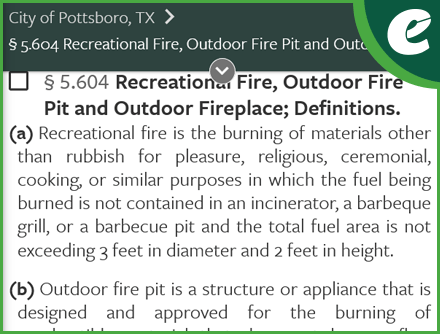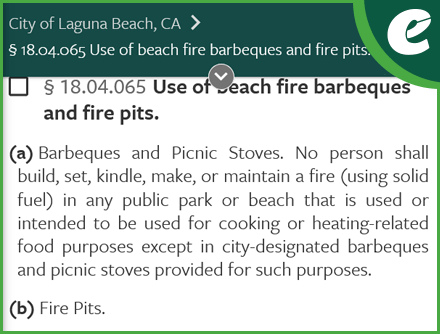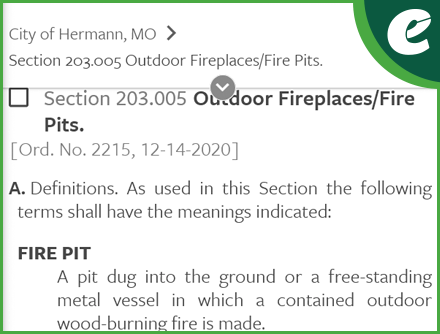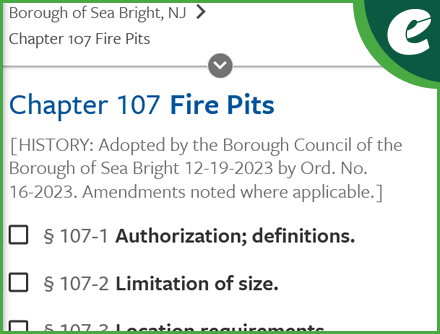There’s nothing like the warmth of a crackling fire on a cool evening.
Outdoor firepits have become a staple in American homes, providing a fun, cozy place to relax and socialize with family and friends. While fire pits are great for creating backyard warmth and ambiance (and a few sticky S’Mores), there are rules to follow when it comes to safety and legal considerations. For homeowners, it’s important that fire pit laws and regulations are clear and understandable so they can avoid fines, keep their families safe, and be good neighbors.
A hot commodity
According to a recent analysis of the industry, nearly 60% of US homes have an outdoor fire pit. Nationally, the fire pits market was valued at 3.09 billion dollars in 2024 and is expected to grow by 5.6% through 2030. This trend certainly makes fire pits a hot commodity among new homeowners and those looking to upgrade their properties.
View sample fire pits legislation >
Can I have a fire pit in my backyard?
There are many areas that have extremely strict restrictions on fire pits and how they are allowed to be used. Whether or not you will be able to have a fire pit at your home depends on a few different factors:
- What the local ordinances outline as required safe distances that fires must be from buildings; generally, this distance is between 20 and 30 feet from any structures
- What is considered a recreational fire (size, location, etc.)
- Rules and guidelines for open burning in your area and whether or not it is legal
- What types of fires necessitate having a permit from the proper authorities
Fire pit classifications
Fire pits come in several distinct types. Each type may face different regulations. Understanding these classifications helps ensure compliance with local regulations.
Traditional wood-burning: These pits burn natural wood for heat and ambiance. They often generate more radiant heat and require a larger safety margin than their gas counterparts. Wood fire pits often face the strictest regulations.
Gas fire pits and tables: These units run on propane or natural gas and offer a cleaner burn with a controlled flame. As a result, they produce minimal smoke and no sparks. Natural gas pits must be at least 10 feet from all burning hazards.
Portable fire pits: These provide flexibility for occasional use and can be stored when not in use. Portable pits need a larger clearance of 15 feet or more.
Permanent fire pits: These are immovable structures normally installed by professionals. They are constructed of approved stone materials on a non-flammable pad and are placed in an area that meets local safety standards. Permanent installations require more planning and often need permits before construction.
Choosing the ideal surface
The ground beneath your fire pit is more than just a stage, it’s a critical component that can impact safety and longevity. Always choose level surfaces that won’t be damaged by heat or stray embers, such as concrete, stone, or brick. Grass and wooden decks are not suitable without proper protection due to their flammable nature and sensitivity to heat.
Play it safe with non-combustible materials
When it comes to fire pit safety, the materials surrounding your fire pit are as important as the wood-burning fire pit itself.
- Create a non-combustible zone around your fire pit, typically using gravel, brick, or concrete pavers. This not only adds a layer of protection but also aesthetically defines the space.
- For added protection, especially on more sensitive surfaces, consider using a fire pit pad or mat designed to shield against heat.
- Before any digging, use the national 811 “Call Before You Dig” service or visit their website to locate underground utilities. Even with shallow fire pits, always ensure you’re clear of gas, water, and electrical lines to prevent service disruptions or dangerous accidents
To burn or not to burn…
Generally, it’s safe to burn natural materials like dried untreated wood, grass clippings, and yard debris, such as sticks and twigs. You can also use fire starters like tinder, firewood, starter logs, and lighter fluid.
However, don’t burn construction waste, garbage, green wood, plastic, or chemicals. Animal remains, manure, plastic, rubber, or wood that is rotted, moldy, diseased, wet, has glue attached, or isn’t full – particle board or plywood also is not safe, even for outdoor burning.
Finally, do not burn household trash – foam, cardboard, aerosol cans, or products with colored ink on wrappers, magazines, or boxes. And never start a fire with gasoline or oil.
Respecting burn bans
Burn bans are temporary restrictions that forbid a fire started by an open flame. They also apply to material that can cause uncontained ember release. Burn bans usually go into place during periods of drought or during the threat or existence of wildfires. Poor air quality and high air pollution can also cause a burn ban to go into effect.
Violations of a burn ban can result in monetary fines, legal actions, or jail time, depending on your local guidelines. Activities that can be off-limits during a prohibition include:
- Bonfires
- Campfires
- Fire rings or pits
- Burn barrels
- Field burning
- Burning debris
Know your local fire pit regulations
State and County Regulations: Your first step is to contact your local government offices. They can provide information on state and county fire pit regulations that may dictate the allowable size of your fire pit, specific materials, and safety features required.
Homeowners’ Association (HOA) Rules: If you’re part of an HOA, a quick review of your community’s covenants or a call to the association can clarify any additional rules you need to follow. They may have restrictions on fire pit placement or bans during certain conditions that go beyond state or local ordinances.
Special Considerations for Drought-Prone Areas: For those in drought-prone regions, it’s critical to adhere to specific fire bans and guidelines that help prevent wildfires. Your local fire department is a great resource for current conditions and restrictions.
For fire pit laws and regulations by state, click here.
Backyard fire pit safety tips
In 2024, wildfires destroyed nearly 2 million acres of land in the US, harming ecosystems, wildlife habitats, and even human domains. Understanding standard fire safety can save you from being a statistic.
A few general safety tips for fire pit use include:
- Clear the area around your pit of any flammable materials like leaves, paper, sticks, etc.
- Don’t use gasoline, lighter fluid, or any other type of petroleum-based accelerant to start or feed your fire.
- Never leave your fire unattended and make sure it’s fully extinguished before you go to bed or leave the area.
- Be mindful of local conditions that could cause your fire to spread, like high winds.
- Have a plan for what you’ll do if your fire gets out of control. Keep a water source close by in case you need to put out the fire quickly.
- Take note of the prevailing wind direction in your backyard, especially during the times you’re most likely to use your fire pit.
- Consult online tools: Websites like the Department of Agriculture provide resources to help you determine dominant wind patterns by region, which can inform the best placement to avoid smoke issues.
Learn how to put out a fire
Always extinguish a fire before leaving it unaccompanied. Embers can hide under the charred materials, giving the appearance of the fire being out only to blaze back up if the wind blows.
If you want to let your fire go out naturally, stop adding accelerant one hour before you want to put the fire out. Instead, use a fire poker, shovel, or another long utensil to move the fire debris around so that the coals don’t touch any large pieces of wood.
If you want the fire out quickly, you can spray the area with water, preferably using a hose and a spray nozzle. A direct stream of water can cause sparks to spread. Stir the remains once more to make sure everything gets saturated.
You can also cover smoldering embers with sand or dirt for metal fire pits or fires that you can’t reach with a water hose. A final method of putting out a backyard fire is with a snuffer. Many fire pits come with snuffers – lids – which suffocate the fire.
Useful examples of fire pits legislation from the eCode360® Library
If your community is interested in drafting or updating legislation related to fire pits in your community, here are some useful examples that can be found in our eCode360 Library:
Updating your municipal code is vitally important
Submit your code updates as soon as possible and ensure constituents and local government officials are always referencing and working with the most up-to-date resources. Make it part of your Board meeting close-out process to send your adopted legislative changes to General Code when everything from that meeting is already right at hand.
Additional resources:
- Fire Pit Surplus: Where To Put Your Fire Pit?
- Grand View Research: Top Fire Pit Statistics, Insights, and Projections for 2020-2030
- Aquarius Landscaping: How Many Fire Pits in the USA?
- Fire Statistics: Wildfire Statistics 2025: The $893 Billion Burning Problem
- eCode360 Library
- OutLand Living: Can I Have A Fire Pit In My Backyard? Laws And Restrictions By State
- The Backyard Master: Backyard Burning—Can I Have A Fire Pit In My Backyard?
- Crown Fire Pits: Are Fire Pits Legal In Your State? A 2025 Guide To Fire Pit Regulations In All 50 States
- Casa Blui Blog: Fire Pit Legal Guide






